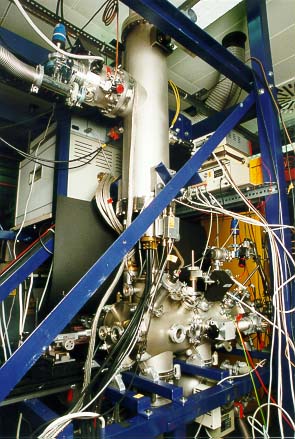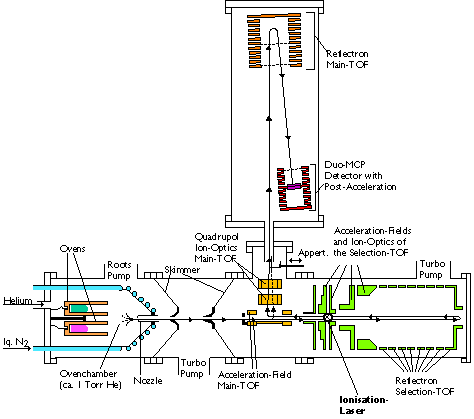Cluster-ToF Mass Spectrometer


The cluster ToF is illustrated by the two sketches on this page. It is a high-resolution time-of-flight mass spectrometer (ToF) with a resolution of up to m/Delta(m) = 40000. This makes it one of the best machines of it’s kind in the world.
Production of clusters
The cluster source shown can produce all kinds of clusters from “simple” metal clusters to sophisticated multi-layered heterogenous clusters. The source is a rare gas aggregation cell containing either one or two ovens to evaporate the various materials to be studied. Alternatively, elements can be evaporated by targeting a laser through a window onto refractory materials inside the oven chamber. A steady helium gas flow cools the vapour(s) inside the oven chamber causing the atoms to condense to clusters. By means of a liquid-nitrogen-cooled nozzle and a system of skimmers, a neutral cluster beam is formed and directed towards the ionization region.
Ionization and acceleration of clusters:
The ionization spot lies within a region of strong electric field which “turns” the clusters by 90 degrees and accelerates them down the drift tube. The clusters first pass a quadrupole focussing section which compensates for the remaining lateral velocity components, and then are bounced back by a reflector field ( => reflectron-TOF) towards the ion detector. The reflection compensates for differences in the starting coordinates (and therefore kinetic energy) of the clusters due to the finite size of the ionization laser spot thereby enhancing the achieved mass resolution. The clusters are detected using a multi-channel-plate as secondary electron multiplier. The arrival times are read out by a TDC (time-to-digital-converter).
A more refined way of preselecting a certain cluster mass range for measurement is made possible by the “Mini-TOF”, which is illustrated in Fig. 2. It is a small reflectron-TOF that can be installed on the axis of the neutral cluster beam. The clusters are ionized just after having entered the acceleration section of the Mini-TOF and return from the Mini-TOF reflector into the main acceleration section already mass separated. The acceleration field of the main TOF is switched on when the clusters of interest are located within the small volume that is projected onto the detector. This small portion of the initial cluster size distribution can then be studied in more detail with the main ToF.

